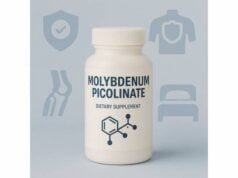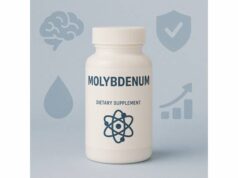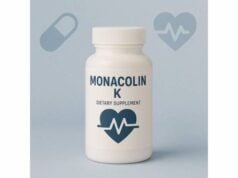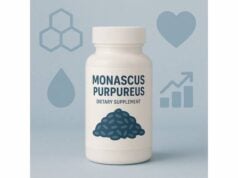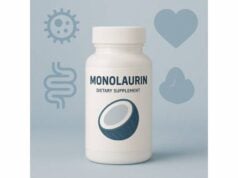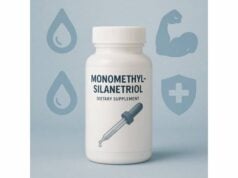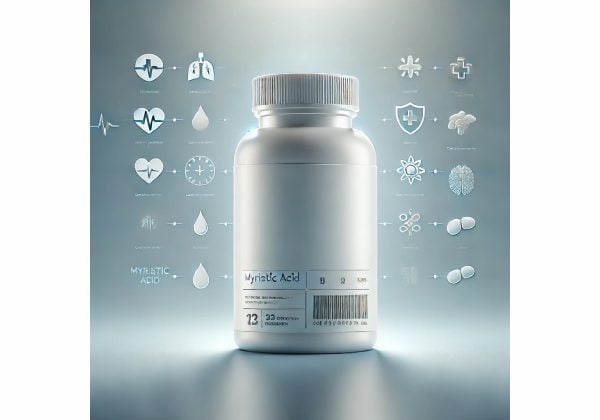
Myristic acid (C14:0) is a saturated fatty acid found naturally in dairy fat, coconut and palm kernel oils, certain fish, and in trace amounts across many foods. It is also a building block in skincare ingredients such as isopropyl myristate and myristyl myristate. Inside the body, myristic acid serves a structural role in cell membranes and—more uniquely—acts as a lipid “tag” (N-myristoylation) that helps specific proteins find the right place in the cell and switch on or off. In everyday nutrition, however, it behaves like other long-chain saturated fats: it tends to raise both LDL (“bad”) and HDL (“good”) cholesterol, with the overall impact shaped by what you eat instead (for example, replacing some saturated fat with unsaturated fats).
This guide translates the science into practical decisions: what myristic acid is, where it shows up in food and products, how it behaves in the body, how much is reasonable, and who may want to limit it. You will also find plain-language safety notes for diet and skin use, plus a concise evidence summary to help you weigh benefits against risks.
Fast Facts
- May modestly increase both LDL and HDL; replacing some saturated fat with unsaturated fats improves lipid profiles.
- Supports essential protein targeting in cells via N-myristoylation (a normal physiological process).
- No supplement dose is recommended; keep total saturated fat under 10% of calories (~20–22 g/day on a 2,000 kcal diet).
- People with high LDL, familial hypercholesterolemia, or cardiovascular disease should limit foods rich in myristic acid.
- Topical esters (for example, isopropyl myristate) can irritate or clog pores in some users; patch-test first.
Table of Contents
- What is myristic acid and how it works
- What benefits are realistic
- How to use it in diet and skincare
- How much is reasonable per day
- Side effects, interactions, and who should avoid
- What the research says: evidence at a glance
What is myristic acid and how it works
Myristic acid is a 14-carbon saturated fatty acid (often written as 14:0 or C14:0). In nutrition science, chain length matters because it influences absorption, transport, and metabolic effects. Medium-chain fatty acids generally have 6–12 carbons; myristic acid sits just beyond that range and is typically categorized as a long-chain saturated fatty acid. That means it is absorbed with bile salts, packaged into chylomicrons, and transported via the lymphatic system—like palmitic (16:0) and stearic (18:0) acids.
Where you’ll find it:
- Dairy fat: Butter and full-fat dairy contain meaningful amounts. Representative analyses show butter fat typically carries a mix of saturated fatty acids, including roughly a third palmitic, about a tenth stearic, and low double-digit myristic.
- Tropical fats: Coconut and palm kernel oils are rich in shorter saturated fats (especially lauric, 12:0) but also contribute myristic acid.
- Marine sources: Some fish contain small amounts of myristic acid, contributing to overall intake within a mixed diet.
What it does in cells is different from what it does in blood lipids. Biologically, myristic acid is used as a post-translational modification called N-myristoylation. During this process, an enzyme (N-myristoyltransferase) attaches myristic acid to a glycine at the very start of select proteins. The lipid tail helps those proteins dock to membranes, assemble into complexes, or respond to signals. Examples include signaling proteins in immune pathways and cell-growth cascades. This modification is essential for normal cell biology; it is not a “bonus” effect you get from eating extra myristic acid, but a routine cellular mechanism that uses the body’s fatty-acid pool.
From a nutrition perspective, myristic acid behaves like other long-chain saturated fats in controlled feeding studies: when it replaces carbohydrate calories, LDL and HDL cholesterol levels usually rise. The magnitude of the change depends on the full diet pattern. Replacing some saturated fat calories with polyunsaturated fats (from nuts, seeds, fish, or plant oils) generally improves LDL.
In consumer products, myristic acid is widely used in esterified forms such as isopropyl myristate (emollient, penetration enhancer) and myristyl myristate (texture and occlusion). These esters change how a formula spreads and feels on skin; they are not the same as dietary myristic acid and are used topically, not orally.
Bottom line: myristic acid is both a normal cell-biology tool (via N-myristoylation) and a common dietary saturated fat. Its physiological roles do not automatically translate into supplemental “benefits,” and its nutritional effects should be weighed within total saturated fat intake and overall diet quality.
What benefits are realistic
When people hear “benefits,” they often expect a supplement-like payoff. Myristic acid rarely functions that way. Instead, consider benefits in three real-world contexts: (1) its role in normal cell biology, (2) its place in dietary patterns, and (3) its use in skincare formulations.
1) Cellular function (N-myristoylation).
N-myristoylation helps specific proteins attach to membranes, assemble signaling complexes, and carry out tasks in immunity, metabolism, and cell growth. This is vitally important for life, but it does not mean that consuming more myristic acid above a typical diet enhances those pathways. Cells regulate N-myristoylation tightly; they do not “up-tag” proteins simply because more substrate is present. The practical takeaway is reassurance: ordinary dietary intake provides adequate substrate for these housekeeping functions.
2) Dietary patterns and lipids.
Myristic acid elevates LDL and HDL cholesterols in controlled diet studies. HDL increases are sometimes cited as a “benefit,” but the balance matters: many experts prioritize lowering LDL or the total-to-HDL ratio over raising HDL alone. Food source and replacement nutrient also matter. For example, swapping some saturated fat for unsaturated fats (olive oil, nuts, seeds, fish) typically lowers LDL. In contrast, adding saturated fat on top of an already high-saturated-fat pattern tends to worsen LDL. In short, the benefit is not in the fatty acid itself, but in how you structure the overall diet.
3) Skin feel, spreadability, and occlusion (topical esters).
In skincare, esters of myristic acid such as isopropyl myristate can make creams silky, less greasy, and more spreadable. For dry, non-acne-prone skin, that can be a tactile upgrade and may support barrier comfort when paired with humectants and ceramides. As a penetration enhancer, these esters can help actives reach their targets—useful in leave-on products designed for efficacy.
Where the benefits top out:
- There is no credible evidence that supplementing pure myristic acid improves health outcomes such as cardiovascular risk, glycemic control, or body weight.
- Cardiometabolic benefits come from what you replace saturated fat with: polyunsaturated fats consistently outperform additional saturated fat for LDL lowering.
- Topical benefits are formulation-dependent: the same ester can feel elegant in one product but pore-clogging or irritating in another, depending on the full ingredient list and your skin type.
Practical framing:
- If your goal is heart health, treat myristic acid as part of your saturated fat budget, not as a functional supplement.
- If your goal is better skin feel, myristic-derived esters can help—but patch-test and watch for congestion if you are acne-prone.
How to use it in diet and skincare
Dietary use: eat patterns, not molecules.
Instead of hunting for or avoiding a single fatty acid, build meals around heart-healthy substitutions:
- Swap in unsaturated fats: use olive, canola, safflower, or walnut oil in place of some butter or tropical oils.
- Choose dairy strategically: fermented options (yogurt, kefir, some cheeses) can fit into balanced diets; monitor portions and overall saturated fat, especially if your LDL is high.
- Lean proteins first: fish, legumes, and poultry make it easier to keep saturated fat under your daily cap.
- Whole-diet thinking: the biggest lipid improvements usually come from replacing saturated fat with polyunsaturated fat and increasing fiber from whole grains, beans, nuts, seeds, fruits, and vegetables.
Recognize common sources.
- Butter and ghee: contribute myristic, palmitic, and stearic acids.
- Coconut oil and palm kernel oil: high in lauric plus notable myristic; best used sparingly if you are managing LDL.
- Packaged foods: read labels for “hydrogenated” or “palm kernel”; routine use can push saturated fat above your daily target.
Kitchen tactics that quietly lower saturated fat
- Roast vegetables with just enough oil to coat; finish with a splash of acid (lemon, vinegar) for flavor instead of more fat.
- Use nuts and seeds to add texture and unsaturated fats (sprinkle, do not pour).
- Blend olive oil with yogurt or silken tofu to create creamy dressings with less saturated fat.
Topical use: isopropyl myristate and friends.
- Skin type matters: dry, non-acne-prone skin often tolerates and enjoys the slip of isopropyl myristate or myristyl myristate.
- Patch-test: apply a pea-sized amount to the inner forearm or behind the ear for 24–48 hours; check for redness or bumps.
- Layer wisely: penetration enhancers can intensify strong actives; pair with gentle routines and avoid stacking multiple irritants.
- Acne-prone caution: if you are prone to closed comedones, consider lighter esters or non-comedogenic alternatives and monitor for congestion.
What not to do
- Do not take standalone myristic acid capsules for health benefits; they are unnecessary and may worsen LDL.
- Do not equate “natural” with “cardioprotective.” Butter and tropical oils are natural but can raise LDL when used generously.
- Do not assume a “non-comedogenic” label guarantees zero breakouts; assess how your own skin responds.
Real-life example (diet)
If you typically cook eggs in butter, try lightly sautéing in olive oil and finishing with herbs. If you enjoy coconut curry, keep the portion modest, load the dish with vegetables and legumes, and skip additional saturated fat at other meals that day. These small shifts respect your palate while keeping total saturated fat in check.
How much is reasonable per day
There is no recommended supplemental dose of myristic acid. Reasonable intake is framed within total saturated fat rather than per-fatty-acid targets.
Daily cap for saturated fat
Aim to keep saturated fat under 10% of total calories. On a 2,000-kcal diet, that is about 20–22 g/day of saturated fat. People with high LDL or established cardiovascular disease are often advised to go lower (for example, 7–9% of calories) as part of individualized care from a clinician or dietitian.
Why there is no “myristic acid dose”
- Human studies evaluate diets, foods, and substitutions—not isolated myristic acid pills—because outcomes depend on what you replace.
- Within mixed diets, myristic acid rarely exists alone; butter, coconut oil, and cheese deliver several saturated fatty acids together.
- Position statements and guidelines focus on total saturated fat caps and replacement with unsaturated fats, which consistently improves LDL and overall cardiometabolic risk markers.
Food examples to make the numbers concrete
- Butter: representative profiles indicate roughly 31% palmitic, ~12% myristic, ~11% stearic among its fatty acids. A tablespoon (~14 g fat) contributes several grams of saturated fat, including myristic.
- Coconut oil: dominated by lauric (12:0) but contains appreciable myristic (14:0); even modest daily spoonfuls can push saturated fat toward (or above) your cap.
- Cheese: varies by style and fat content; check the label.
Timing
There is no timing advantage for myristic acid itself. For heart-health goals, what you replace and how much saturated fat you consume over the day matter more than when you eat it.
For skincare
Topical esters that include myristic acid are measured in percent of the formula, not milligrams. Many leave-on products use single-digit to low double-digit percentages. Follow product instructions; more is not better if irritation or breakouts follow.
Practical targets to remember
- Total saturated fat: ≤10% of calories (≈20–22 g/day at 2,000 kcal).
- Replace with unsaturated fats when possible.
- Avoid isolated myristic acid supplements; they offer no proven benefit and can aggravate LDL.
Side effects, interactions, and who should avoid
Dietary side effects and cautions
- Lipid changes: Diets higher in myristic acid tend to raise LDL cholesterol, even as HDL may also rise. For risk reduction, lowering LDL is the priority for most people.
- Cardiovascular risk management: If you have elevated LDL, familial hypercholesterolemia, atherosclerotic cardiovascular disease, or diabetes, you should be especially mindful of total saturated fat. Replace some saturated fat with polyunsaturated fats and increase soluble fiber.
- Blood markers and weight: Swapping saturated fat for unsaturated fats can improve LDL without increasing triglycerides; adding saturated fat on top of total calories may raise LDL and weight over time.
- Special populations: Pregnancy and lactation require balanced nutrition, not restriction extremes. Focus on overall diet quality; avoid high-dose fat supplements unless recommended by a clinician.
Topical side effects (isopropyl myristate and related esters)
- Irritation or comedones: Some individuals—especially those with acne-prone skin—report clogged pores or small bumps with isopropyl myristate–rich formulas.
- Contact allergy: Rare but possible. A simple patch test helps detect sensitivity before applying widely.
- Interaction with actives: As penetration enhancers, these esters can increase the delivery of retinoids or acids; that is helpful in well-designed formulas but may also intensify irritation if you layer strong actives.
Medication interactions
- No direct drug–nutrient interactions are unique to myristic acid. The main interaction is indirect: if you are on lipid-lowering therapy, a diet high in saturated fat fights your treatment goals.
Who should limit or avoid higher myristic-acid foods
- People with high LDL, familial hypercholesterolemia, or established cardiovascular disease.
- Those with acne-prone skin who notice congestion with products rich in isopropyl myristate.
- Anyone advised by a clinician to follow a therapeutic lipid-lowering diet.
When to seek personalized advice
If your LDL remains high after making substitutions (for example, switching butter to olive oil, increasing nuts and seeds), consult a registered dietitian or your healthcare provider. Lipids respond to both diet and genetics; you may need a tailored plan.
What the research says: evidence at a glance
Myristic acid and blood lipids
Controlled feeding trials and diet substitutions consistently show that myristic acid raises LDL and HDL when it replaces carbohydrate calories. The size of the effect varies with the food matrix and the nutrient it replaces. Replacing some saturated fat with polyunsaturated fats lowers LDL more reliably than adding or maintaining myristic-rich fats. Large guidelines recommend keeping saturated fat below 10% of calories for cardiometabolic risk reduction.
Food-based trials
Randomized comparisons of butter, olive oil, and coconut oil demonstrate that different fats shift specific fatty acids in blood. Coconut oil, for example, increases lauric (12:0) and myristic (14:0) in plasma phospholipids, while butter increases odd-chain saturated markers of dairy fat. Importantly, short-term changes in these fatty-acid markers do not necessarily translate into improved LDL; the broader pattern (more unsaturated, fewer saturated) still predicts better lipid profiles.
Chain length matters—contextually
Shorter saturated fats (like lauric, 12:0) may raise HDL more and sometimes shift the total-to-HDL ratio differently than longer saturated fats (palmitic, 16:0). Myristic (14:0) generally behaves more like palmitic than like unsaturated fats. Observational cohort results sometimes differ by country and food source (for example, dairy-dominant versus meat-dominant saturated fat), underscoring that the food matrix and replacement nutrient influence risk.
Cell biology is essential but not a supplementation target
N-myristoylation is a fundamental cellular process that uses myristic acid to anchor or regulate proteins in signaling, immunity, and membrane dynamics. This supports the concept that adequate dietary fat is necessary for normal physiology. But there is no evidence that consuming extra myristic acid beyond typical dietary amounts enhances these pathways or improves health outcomes.
Topical esters: benefits with caveats
Isopropyl myristate and related esters can improve product feel and help actives penetrate the skin. They are widely used and generally well tolerated, yet a subset of users—especially acne-prone individuals—may experience clogged pores or irritation. Patch-testing and ingredient awareness are prudent.
Practical synthesis
- Treat myristic acid as part of your saturated fat budget.
- Favor unsaturated fat substitutions for lipid management.
- Use topical esters thoughtfully based on your skin type and routine.
- Skip myristic acid supplements; they lack proven health benefits and may impede lipid goals.
References
- Saturated Fatty Acid and Trans-Fatty Acid Intake for Adults and Children: WHO Guideline 2023 (Guideline)
- Effects of coconut oil, olive oil, and butter on plasma fatty acids and metabolic risk factors: a randomized trial 2024 (RCT)
- Protein posttranslational modifications in health and diseases: Functions, regulatory mechanisms, and therapeutic implications 2023 (Review; includes N-myristoylation)
- The Short Overview on the Relevance of Fatty Acids for Human Cardiovascular Disorders 2020 (Review)
- Impact of Replacement of Individual Dietary SFAs on Circulating Lipids and Other Biomarkers of Cardiometabolic Health: A Systematic Review and Meta-analysis of Randomized Controlled Trials in Humans 2022 (Systematic Review and Meta-analysis)
Disclaimer
This article is educational and does not replace personalized medical advice, diagnosis, or treatment. Nutrition and skincare choices should reflect your health history, current medications, lab values, and goals. Consult a qualified healthcare professional for guidance tailored to you.
If you found this helpful, consider sharing it on Facebook, X (formerly Twitter), or your preferred platform, and follow us for future updates. Your support helps us keep producing clear, evidence-based guides.

